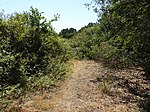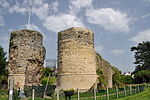Broome Heath
Local Nature Reserves in Norfolk

Broome Heath is a 31.7-hectare (78-acre) Local Nature Reserve in Ditchingham in Norfolk, England. It is owned by South Norfolk District Council and managed by the Broads Authority. An area in the north is designated a geological Site of Special Scientific Interest as Broome Heath Pit, and there is a Scheduled Monument in the middle.This site in the valley of the River Waveney has marshy grazing land and lakes. At the southern end there is a Neolithic settlement, and in the middle there are long and round barrows.There is access from Loddon Road.
Excerpt from the Wikipedia article Broome Heath (License: CC BY-SA 3.0, Authors, Images).Broome Heath
Loddon Road, South Norfolk Ditchingham
Geographical coordinates (GPS) Address Nearby Places Show on map
Geographical coordinates (GPS)
| Latitude | Longitude |
|---|---|
| N 52.47 ° | E 1.453 ° |
Address
Loddon Road
NR35 2RA South Norfolk, Ditchingham
England, United Kingdom
Open on Google Maps









